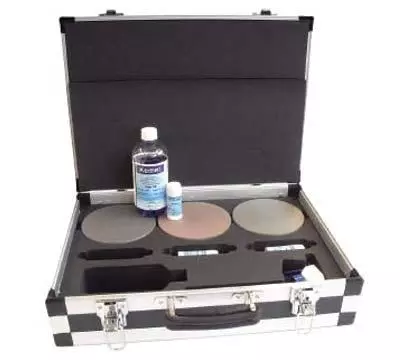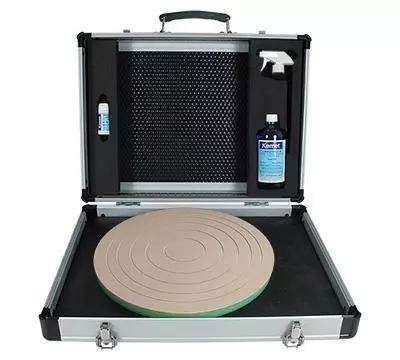Hand Lapping Techniques
Operating Instructions & Lapping Techniques for the 'Kemet 3 Lap Kit'
Contents:1 x 150mm dia. Kemet Iron Hand Lap, 1 x 150mm dia. Kemet XP Hand Lap,
1 x 150mm dia. Kemet Tin Hand Lap,
1 x 25 Micron Kemet Application Stick,
1 x 8 Micron Kemet Application Stick,
1 x 3 Micron Kemet Application Stick,
1 x Trigger Spray Type ‘OS’ Lubricating Fluid
Preparation of hand lapping plates
Ensure the lapping plates are clean before use. Apply the appropriate Kemet Diamond Compound sparingly on the plate. Too much compound may lengthen the lapping time! Spray some fluid on the plate. Too much fluid may reduce the cutting action of the Diamond Compound! The plate surface should only be moist, not wet! Charging the lap plates should, if possible, take place outside the carrying case. Put the plates on a flat and sturdy surface. The anti-slip layer underneath the plates prevents them from moving.
First hand lapping operation
Use the Kemet Iron Plate with Kemet 25 Micron Stick Compound (Mahogany) and Kemet Fluid. Clean the component to be lapped, chamfering sharp or chipped edges if necessary, hold it between three fingers and put it on the plate. Move it in an ‘8’ pattern on the plate applying light pressure, first in short loops to spread the compound, thereafter on long moves over the entire plate surface.
Check the component regularly until clean up has been achieved. Should you have any more components to lap it is recommended to carry out the first lapping operation on all of them before proceeding to finer lapping.
After about 5 minutes of lapping, depending on the surface to be lapped, the plate should be cleaned again and new compound applied.
After the first lapping operation clean both plate and components thoroughly. Spray some fluid on the plate before putting it back into its case.
Second lapping operation
Use the Kemet XP Plate with 8 Micron Kemet Stick Compound (Red) and Kemet Fluid. Check again that the component is absolutely clean before starting the second lapping operation. Now lap the component until the scratches of the first lapping operation have been completely removed and a new smooth surface has been obtained. The scratch pattern now looks finer: on many material types some reflection should already be visible.
Finishing
Use the Kemet Tin Plate with 3 Micron Kemet Stick Compound (Green) and Kemet Fluid. Check again that the component is absolutely clean before starting the finishing operation. Lap as before and stop the finishing operation when the scratches of the second lapping operation have been completely removed and a new smooth surface has been obtained. On most types of material a reflective or mirror finish will have resulted.
Operating Instructions & Lapping Techniques for the 'Kemet Hand Lap Kit (Type L & P)'
Contents:
1 x Kemet Iron Hand Lap or Kemet XP Hand Lap
1 x Kemet KD Diamond Compound Application Stick 25 Micron or 3 Micron
1 x Containers of Kemet OS Lubricating Fluid
TYPE L for Lapping
TYPE P for Polishing
For hand lapping and polishing a wide range of hard and soft materials, including ceramic, tungsten carbide, stellite, hard and soft steel, silicon nitride, brass, etc.
Method of Use for Lapping or Polishing
- Ensure the surface of the Kemet Iron Lap or Kemet XP Lap is dry and clean.
- Remove the top of the 25 Micron or 3 Micron Kemet Diamond Compound Application Stick and by twisting the knurled base expose a small proportion of the compound.
- Apply the compound sparingly to the surface of the lap in 4 or 5 random areas.
- Moisten the surface of the lap with the Kemet Lubricating Fluid (Type OS).
- Place the workpiece on the lap and work it lightly in a ‘figure 8’ action so as to spread the compound. At first the action should be around the outer edge of the plate, followed by a more general action covering the whole of its surface.
- The workpiece can be lapped by applying a firm pressure, again in a ‘figure 8’ action. It is advisable to change the holding position at regular intervals and to use the full surface of the lap.
- Re-charge the lap every 5 minutes or so of use by wiping clean and applying a further small quantity of 25 Micron Kemet Diamond Compound and Lubricating Fluid.
Polishing
Ensure any workpiece is thoroughly clean before polishing. Apply only small amounts of Lubricating Fluid. As a basic principle, a better polished result is obtained if the Kemet XP Lap is ‘just moist’.
Note: For lapping components such as Safety Relief Valves, the Kemet Plate can be removed from its case and used by working in a random action on top of the workpiece.
Operating Instructions & Lapping Techniques for the 'Kemet Carbon Dry Lapping Kit'
The Kemet Carbon Seal Dry Lapping Kit consists of the following:
Textured Lapping Plate: This is a lapping plate with a textured surface. The plate has been lapped flat to generate flat components, and has a specially textured surface which removes material, and generates a flat polished carbon face without the addition of any loose abrasive.
Roughing Pad: This should be used in combination with the “Plate Wash” fluid to remove excessive carbon build up on the plate. Too much carbon will reduce the performance of the textured plate. The rough surface of the pad will also texture the lapping plate to extend the life of the plate between re-lapping operations.
Plate Wash: This is a pre-mixed aqueous detergent which should be used when cleaning the plate after use.
- Ensure the surfaces of the lapping plate, and carbon components are clean and free from any contamination. Any contamination will affect the results.
- Using firm hand pressure, move the component over the surface of the lapping plate in a figure of 8 motion.
- Use as much of the plate surface as possible, rotating the plate from time to time to evenly wear the surface.
- After ten figure of 8 motions, rotate the component by 90 degrees. This will maintain the parallel geometry of the part.
- When the carbon face displays an equally polished surface in all areas, clean and inspect for flatness.
- It is not necessary to clean the lapping plate after every component, but excessive carbon build up will affect the performance of the plate.
- Kemet recommend that the lapping plate is cleaned after each batch of components have been processed.
Over time the textured plate will require re texturing and flattening. Plates should be returned to Kemet for this procedure.



